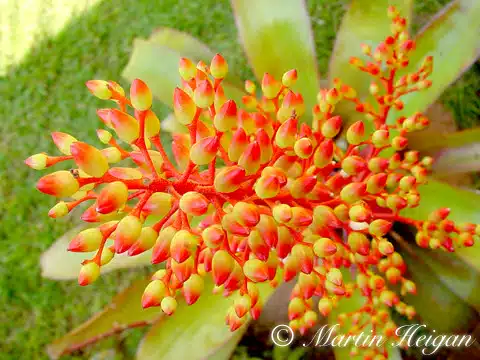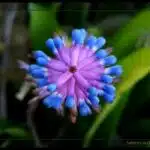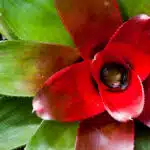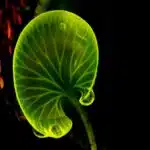Aechmea bromeliads are among the most sought-after indoor plants that are both easy to grow and maintain. These tropical plants belong to the Bromeliaceae family, which is known for its diverse range of species and striking ornamental foliage. As a horticulture expert, I have come across many plant enthusiasts who struggle to care for their Aechmea bromeliads due to the lack of proper guidance. In this article, we will provide a comprehensive growth and care guide for Aechmea bromeliads that will help plant lovers serve their leafy companions in the best possible way.
Aechmea bromeliads are native to South America and can grow up to 1-2 feet tall in ideal conditions. They have long, slender leaves that form a rosette-like structure at the base, from which they produce attractive inflorescences with bright floral bracts in shades of pink, red or orange. Growing Aechmea bromeliads requires minimal effort as these plants thrive in partial shade and moderate humidity levels. However, providing optimal growing conditions such as well-draining soil, appropriate watering schedules and adequate fertilization is essential for promoting healthy growth and vibrant blooms. In the following sections, we will delve into more detail on how to care for your Aechmea bromeliad at every stage of its growth cycle.
A Brief Introduction To Aechmea Bromeliads
As the old adage goes, “knowledge is power.” This is especially true when it comes to cultivating Aechmea bromeliads. Understanding their origins and physical characteristics can provide invaluable insight into their growth and care.
Aechmea bromeliads are native to Central and South America. They belong to the Bromeliaceae family, which includes over 3,000 species of tropical plants. These hardy plants are known for their unique foliage and long-lasting blooms.
The physical characteristics of Aechmea bromeliads make them a popular choice among plant enthusiasts. Their leaves are typically thick and leathery with spiny edges, providing a natural defense against predators. The plant’s inflorescence features bright-colored flowers that can last up to six months, making them a stunning addition to any indoor or outdoor garden. By understanding these traits, you’ll be better equipped to care for your Aechmea bromeliad throughout its growth cycle.
Transitioning into understanding the growth cycle of Aechmea bromeliads, it’s important to note that these plants have unique needs at each stage of development.
Understanding The Growth Cycle Of Aechmea Bromeliads
Aechmea bromeliads are fascinating plants with unique growth patterns that make them popular among plant enthusiasts. Understanding the growth cycle of aechmea bromeliads is essential to ensure their proper care and maintenance. These plants have a slow-growing habit, and it may take several years before they reach maturity.
Pruning techniques are essential in ensuring that your aechmea bromeliad remains healthy and attractive. Dead or damaged leaves should be removed promptly to prevent the spread of diseases or pests. However, avoid over-pruning as it may cause stress to the plant, leading to stunted growth or even death. It’s best to prune only when necessary, and always use sterile tools to prevent contamination.
Aechmea bromeliads typically bloom once a year, producing colorful inflorescences that can last for several weeks. The blooming pattern may vary depending on the species, but most aechmeas bloom during late winter or early spring. After flowering, the mother plant will produce offsets or pups around its base, which can be carefully removed and planted separately to grow into new plants. By understanding the growth cycle of your aechmea bromeliad, you’ll be able to provide optimal care and enjoy its beauty for years to come.
Understanding pruning techniques and blooming patterns are essential aspects of caring for your aechmea bromeliad. However, choosing the right pot and soil is equally important in ensuring its proper growth and development. In the next section, we’ll discuss how to select the appropriate pot size and soil type for your aechmea bromeliad’s specific needs.
Choosing The Right Pot And Soil For Your Aechmea Bromeliad
The pot and soil selection is a crucial aspect of growing healthy aechmea bromeliads. When it comes to choosing decorative pots, keep in mind that the size should be relative to the plant’s root system. A pot too small can stunt growth, while one too big may cause waterlogging. Decorative pots with sufficient drainage holes are ideal as they prevent water accumulation at the bottom.
In terms of soil mixture, a well-draining medium is necessary for optimal growth. An ideal soil mixture for aechmea bromeliads includes peat moss, perlite or vermiculite, and bark chips or charcoal chunks. This combination provides adequate moisture retention and drainage while also allowing air circulation around the roots.
To evoke emotion in aspiring plant parents, consider these tips when choosing pots and soil for your aechmea bromeliad:
- Pick a pot that complements your décor style and adds vibrancy to your living space.
- Opt for an eco-friendly pot made from sustainable materials such as recycled plastic or bamboo.
- Use organic soil mixtures to promote natural growth without chemicals or pesticides.
Choosing the right pot and soil is essential to ensure your aechmea bromeliad thrives in its new home. The next step in caring for your plant involves proper watering techniques to maintain optimal health. Read on to learn about dos and don’ts when watering your aechmea bromeliad.
Watering Your Aechmea Bromeliad: Dos And Don’ts
As the saying goes, “water is life.” This holds true for aechmea bromeliads as well. Watering this plant correctly is crucial to its survival and growth. Over watering can lead to root rot, while under watering can cause dehydration.
To prevent over watering, make sure that the soil is dry before watering again. Aechmea bromeliads are susceptible to root rot when watered too frequently. It’s important to optimize the frequency of watering based on your plant’s specific needs. The best way to know if your aechmea bromeliad needs water is by checking the soil’s moisture content regularly.
When it comes to optimizing watering frequency, there are several factors to consider. These include the temperature, humidity levels, and sunlight exposure in your environment. In hotter and drier environments, you may need to water more frequently than in cooler and more humid environments. Similarly, if your aechmea bromeliad is exposed to direct sunlight for extended periods, it may require more frequent watering as well.
To ensure optimal growth for your aechmea bromeliad, proper watering practices are essential. By preventing over watering and optimizing watering frequency based on environmental conditions and plant needs, you can help your plant thrive. Next up: fertilizing your aechmea bromeliad for optimal growth – let’s dive in!
Fertilizing Your Aechmea Bromeliad For Optimal Growth
Fertilizing is a critical aspect of caring for your Aechmea bromeliad. It provides essential nutrients that your plant needs to grow and thrive. When it comes to fertilizers, there are two main types: organic and synthetic. Each has its advantages and disadvantages.
Organic fertilizers are made from natural materials such as compost or manure. They release nutrients slowly over time, providing a steady supply of food for your plant. They also help improve soil structure and increase the number of beneficial microorganisms in the soil. However, they can be more expensive than synthetic fertilizers and may not provide all the necessary nutrients.
Synthetic fertilizers, on the other hand, are made from chemical compounds that provide a quick boost of nutrients to your plant. They are often less expensive than organic fertilizers and are readily available at most garden centers. However, they can be harmful to beneficial microorganisms in the soil if overused, leading to soil depletion over time.
When it comes to frequency of fertilizing, it’s important not to overdo it. Too much fertilizer can cause damage to your plant’s roots and even kill it. As a general rule, you should only fertilize once every three months during the growing season (spring through fall). During the winter months when your plant is dormant, you don’t need to fertilize at all.
Providing adequate light and temperature for your Aechmea bromeliad is essential for its overall health and growth. Without proper lighting conditions, your plant may not flower or produce new leaves as quickly as it should. Temperature also plays an important role in how well your Aechmea bromeliad grows. Typically, this plant prefers temperatures between 60-80 degrees Fahrenheit (15-27 degrees Celsius). By providing optimal lighting conditions and temperature ranges, you’ll ensure that your Aechmea bromeliad thrives for years to come.
Providing Adequate Light And Temperature For Your Aechmea Bromeliad
As a horticulturist or plant care specialist, you want to make sure that your Aechmea Bromeliad is receiving the adequate amount of light and temperature range it needs to thrive. It is crucial to understand the importance of these factors in maintaining healthy growth and development of your plant. In this section, we will discuss how to provide adequate light intensity and temperature range for your Aechmea Bromeliad.
Firstly, let’s talk about light intensity. Aechmea Bromeliads are epiphytes, which means they grow in trees in their natural habitat. Therefore, they require bright but indirect light to flourish indoors. Direct sunlight can scorch their leaves and cause damage, so it is best to place them near a window that receives filtered or partial sunlight. Consider rotating your plant every few days to ensure even growth since they tend to lean towards the source of light.
Secondly, let’s discuss temperature range. Aechmea Bromeliads prefer warm temperatures between 60-80°F (15-27°C). They are susceptible to damage from frost or prolonged exposure to cold temperatures below 50°F (10°C). Make sure to keep them away from drafty areas such as air conditioning vents or open windows during winter months. Additionally, maintaining humidity levels between 40-60% will help prevent leaf browning and promote healthy growth.
To provide adequate light intensity and temperature range for your Aechmea Bromeliad:
- Place your plant near a window with filtered or partial sunlight.
- Rotate your plant every few days for even growth.
- Maintain warm temperatures between 60-80°F (15-27°C).
- Keep humidity levels between 40-60%.
Now that you know how to properly provide adequate light intensity and temperature range for your Aechmea Bromeliad, let’s move on to pruning and propagating your plant for optimal health and growth.
Pruning And Propagating Your Aechmea Bromeliad
Pruning an aechmea bromeliad should be done in the early spring season and should involve the removal of dead foliage and flower spikes. Propagating the aechmea bromeliad is done by removing offsets or pups from the mother plant. Fertilizing is important for the aechmea bromeliad to ensure the soil has the necessary nutrients for the plant to grow. Soil requirements for an aechmea bromeliad should be well-draining and contain organic matter.
Pruning
Pruning is an essential aspect of aechmea bromeliad care that can help keep your plant healthy and attractive. Pruning techniques vary depending on the specific needs of your bromeliad, but generally involve removing dead or damaged leaves, cutting back overgrown foliage, and trimming off spent flower spikes. It’s crucial to use sharp, sterilized pruning tools to prevent the spread of disease and ensure clean cuts.
One of the most common pruning mistakes that people make with their aechmea bromeliads is removing too many leaves at once. While it may be tempting to strip away any yellowing or brown foliage, doing so can put unnecessary stress on the plant and lead to further damage. Instead, focus on removing only the dead or dying leaves as needed, and avoid cutting into healthy green tissue whenever possible.
Another mistake to watch out for when pruning your aechmea bromeliad is cutting off new growth before it has a chance to mature. This is especially important when dealing with pups (baby plants) that develop at the base of mature plants. While it may be tempting to separate these pups as soon as they appear, it’s best to wait until they are at least one-third the size of the parent plant before removing them. This will give them a better chance of survival and ensure that they have enough energy reserves to grow into healthy adults.
Propagating
When it comes to taking care of your aechmea bromeliad, pruning is just one of the many tasks that you need to take on. Another crucial aspect of plant care is propagation, which involves creating new plants from the parent plant. Propagation can be done through various methods, including division and offsets. Before propagating your aechmea bromeliads, however, it’s essential to understand the best techniques and timing for optimal results.
One tip for propagating aechmea bromeliads is to ensure that the parent plant is healthy and mature enough to produce viable offspring. This means waiting until the plant has reached its full potential before attempting to propagate it. Additionally, you’ll want to choose the right time of year for propagation; generally speaking, spring and summer are the best times for this process.
When it comes to specific techniques for propagating aechmea bromeliads, there are several options available. One popular method is division, which involves separating the parent plant into smaller sections that can each grow into new plants. Another option is offsetting, which involves removing small “baby” plants (or pups) that grow at the base of mature plants and transplanting them into their own containers. Whatever method you choose, make sure to use clean tools and follow proper guidelines for care and maintenance throughout the propagation process.
Dealing With Common Pests And Diseases In Aechmea Bromeliads
Preventative measures are crucial in avoiding common pests and diseases that can affect aechmea bromeliads. One of the most effective ways to prevent infestations and infections is to maintain good plant hygiene. This includes regularly removing any dead or damaged leaves, debris, and fallen flowers from around the plant. It is also essential to ensure that the soil is well-drained and not waterlogged, as this can lead to root rot.
Even with good preventative measures, pests and diseases can still occur in aechmea bromeliads. Identifying common problems is the first step in dealing with them effectively. Some of the most common pests include mealybugs, spider mites, and scale insects. These pests can cause wilting, yellowing of leaves, and stunted growth. Common diseases include fungal infections such as leaf spot and bacterial rots which can cause blackening of leaves.
Natural remedies for pests and diseases in aechmea bromeliads are available for those who prefer not to use chemical treatments. For example, spraying a solution of neem oil mixed with water on the affected areas can help control pest infestations. Additionally, using a mixture of baking soda and water as a foliar spray has been known to help prevent fungal infections. However, it’s important to note that prevention is always better than cure when it comes to pest and disease management in plants.
To maintain optimal growth conditions for your aechmea bromeliad, creating a humid environment may be necessary. This will be discussed further in the subsequent section about tips for fostering healthy growth in your aechmea bromeliad.
Tips For Creating A Humid Environment For Your Aechmea Bromeliad
Dealing with common pests and diseases in aechmea bromeliads is essential to their overall health and growth. However, creating a humid environment for your aechmea bromeliad is equally important. Humidity control is crucial for these tropical plants as they require high humidity levels to thrive.
Misting techniques are one of the easiest ways to increase humidity around your aechmea bromeliad. Simply fill a spray bottle with water and mist the plant’s foliage once or twice a day. Another way to increase humidity is by placing the plant on a tray filled with pebbles and water. This creates a microclimate around the plant that will help retain moisture in the air.
It’s important to note that not all aechmea bromeliad varieties require the same level of humidity. Some species can tolerate lower humidity levels, while others require very high levels to survive. When choosing an aechmea bromeliad variety for your home, consider the environment you can provide for it and choose accordingly.
Aechmea Bromeliad Varieties: Choosing The Right One For Your Home
Are you considering adding an aechmea bromeliad to your home? With so many varieties available, choosing the right one can be overwhelming. Here are some things to consider when selecting the perfect aechmea bromeliad for your indoor or outdoor space.
Size: Aechmea bromeliads come in varying sizes, from small tabletop specimens to large floor plants. Consider the dimensions of your space and choose a plant that will fit comfortably without overwhelming the area.
Light Requirements: Some aechmea bromeliads prefer bright, indirect light, while others can tolerate lower light conditions. Determine the amount of natural light your space receives and select a variety that will thrive in those conditions.
Watering Needs: Aechmea bromeliads have different watering needs depending on their variety and placement. Some prefer to be misted regularly, while others require more thorough watering less frequently.
Indoor Placement vs Outdoor Placement: While some aechmea bromeliads can thrive indoors, others prefer outdoor conditions with higher humidity levels and direct sunlight exposure. Consider where you intend to place your plant and choose a variety that will flourish in that environment.
By carefully considering these factors, you can select an aechmea bromeliad variety that is well-suited for your home’s unique conditions. In the next section, we’ll explore how to properly repot your new plant for optimal growth and health.
A Comprehensive Guide To Aechmea Bromeliad Repotting
Aechmea bromeliads are a popular choice for many plant enthusiasts due to their vibrant colors and unique appearance. However, like all plants, they require proper care and maintenance to thrive. One essential aspect of caring for aechmea bromeliads is the repotting process. Repotting should be done when the plant outgrows its current container or when roots start to grow through the drainage holes.
When repotting aechmea bromeliads, it is crucial to use the right technique to avoid damaging the plant. First, gently remove any dead leaves or debris from the base of the plant. Then, carefully loosen the soil around the root ball using a fork or other suitable tool. Next, lift the plant out of its current container and inspect its roots for any damage or signs of disease.
One of the most common mistakes made during repotting is using a container that is too large for the plant’s size. A container that is too big can cause waterlogging and lead to root rot. Additionally, over-packing soil around the roots can lead to poor drainage and suffocation of roots. Therefore, it is best to choose a pot that is only slightly larger than its previous one and ensure proper drainage by adding pebbles at bottom layers before filling with soil. Following these repotting techniques will help keep your aechmea bromeliad healthy and thriving for years to come.
Transiting into troubleshooting common growth problems in aechmea bromeliads, it’s important to note that even after following proper repotting techniques, certain issues can arise that may affect your plant’s growth patterns. These issues include pests infestation, inadequate sunlight exposure, watering problems among others which will be discussed in detail in subsequent sections below.
Troubleshooting Common Growth Problems In Aechmea Bromeliads
Pests: Aechmea bromeliads may experience infestations from various pests such as mites, aphids, and mealybugs. Watering: Appropriate watering practices for an Aechmea bromeliad should involve allowing the soil to dry out between watering cycles. Light Exposure: When exposed to too much light, Aechmea bromeliads may become sunburned, resulting in bleached or discolored leaves. Pests: To prevent pest infestations, it is important to inspect the plant periodically and take steps to eliminate the pests if necessary. Watering: Too little or too much water can result in wilting, yellowing, or rotting of the leaves. Light Exposure: It is important to protect Aechmea bromeliads from full sun exposure to avoid sunburn and to ensure proper growth.
Pests
As a horticulture expert, it is important to prevent infestations of pests in Aechmea bromeliads. These plants can be susceptible to insect pests such as aphids, mealybugs and spider mites which can cause significant damage if left unchecked. To prevent infestations, it is recommended to inspect the plant regularly and remove any dead or dying leaves or flowers. Additionally, keeping the plant healthy through proper watering and fertilization will make it less attractive to pests.
Natural pest control methods are preferred over chemical pesticides when dealing with Aechmea bromeliads since they are sensitive to chemicals. One effective method is using beneficial insects such as ladybugs or lacewings which feed on aphids and other soft-bodied insects. Another option is using neem oil, a natural pesticide derived from the seeds of the neem tree, which has been shown to effectively control a variety of insect pests while being safe for the plant.
In conclusion, preventing pest infestations in Aechmea bromeliads is crucial for their growth and care. Regular inspection and removal of dead plant parts coupled with proper watering and fertilization will help keep them healthy and less vulnerable to insects. Natural pest control methods such as beneficial insects or neem oil should be utilized instead of chemical pesticides to avoid damaging the plant’s delicate ecosystem.
Watering
Watering is a crucial aspect of caring for Aechmea bromeliads, and it can significantly impact their growth and overall health. When it comes to watering frequency, it is important to strike a balance between keeping the soil moist and avoiding overwatering. Overwatering can lead to root rot, which is a common problem in bromeliads. Signs of overwatering include wilting leaves, yellow or brown spots on the leaves, and a foul odor coming from the soil.
To prevent overwatering, it is recommended to allow the top inch of soil to dry out before watering again. This can be achieved by using well-draining soil that allows excess water to drain away from the roots. It is also essential to avoid leaving standing water in the plant’s central cup as this can promote bacterial growth and rotting.
In summary, proper watering techniques are crucial when troubleshooting common growth problems in Aechmea bromeliads. Watering frequency should be balanced to avoid overwatering while ensuring that the soil remains moist enough for healthy growth. Signs of overwatering should be closely monitored, and steps taken to prevent root rot and other related issues.
Light Exposure
As a horticulture expert or plant care specialist, it is essential to understand the role of light exposure in the growth and development of Aechmea bromeliads. These plants require adequate light to photosynthesize and produce energy for healthy growth. However, determining the optimal light exposure can be challenging as different types of bromeliads have specific light requirements.
Natural sunlight is ideal for Aechmea bromeliads as it provides a full spectrum of light that is necessary for their growth needs. However, not all homes or offices have access to natural sunlight, which may require artificial lighting options. When selecting artificial lighting sources, it is crucial to consider the intensity and duration of light exposure. Bromeliads need approximately 12 hours of light per day, with a balance between red and blue wavelengths.
To achieve optimal growth results, horticulturists may need to experiment with different light sources and durations until they find what works best for their Aechmea bromeliads. It is also important to note that too much or too little light can cause growth problems such as stunted growth or leaf scorching. Therefore, monitoring the amount and duration of light exposure is crucial when troubleshooting common growth problems in Aechmea bromeliads.
Understanding The Blooming Cycle Of Aechmea Bromeliads
Now that we have discussed some common growth problems in Aechmea Bromeliads, let’s move on to understanding their blooming cycle. Blooming is the most rewarding part of caring for these plants and it marks the end of their growth cycle. Understanding this process can help you take care of your plant better and ensure a healthy blooming season.
Aechmea bromeliads go through two different types of blooming cycles – seasonal and non-seasonal. Seasonal blooming occurs during a particular time of year, usually in late spring or early summer. Non-seasonal blooming, on the other hand, can happen at any time throughout the year. The duration of their blooming period varies depending on the species but generally lasts anywhere from a few days to several weeks.
Now that you understand the blooming cycle of Aechmea Bromeliads, let’s discuss some tips for promoting blooming in your plants:
- Give them enough light: These plants thrive in bright but indirect sunlight.
- Keep them warm: They prefer temperatures between 60-80 degrees Fahrenheit.
- Water them properly: Overwatering or underwatering can prevent them from blooming. Make sure to water them only when the soil is dry to touch.
- Fertilize regularly: Use a balanced fertilizer once a month during growing season to promote healthy growth and flowering.
By following these tips, you can ensure that your Aechmea bromeliad blooms beautifully every season. In the next section, we will discuss how to display and arrange your plants to showcase their beauty at its best.
Tips For Displaying And Arranging Your Aechmea Bromeliads
Displaying and arranging your aechmea bromeliads is just as important as growing them. A well-arranged arrangement can make all the difference in showcasing the beauty of your plants. Here are some displaying ideas and arranging techniques that will help you create a stunning display.
Firstly, consider placing your aechmea bromeliads in a group on a table or shelf. You can play with height by using plant stands or by placing taller plants in the back and shorter ones in front. Alternatively, you can place them individually in different decorative pots around your home or office. This will allow each plant to stand out on its own while still adding to the overall aesthetic appeal.
Another great way to display your aechmea bromeliads is by hanging them from the ceiling or on walls. This not only adds an interesting visual element but also frees up floor space. Use macrame plant hangers or mounted shelves to create interesting arrangements that draw attention to your plants.
Table 1: Displaying Ideas and Arranging Techniques
| Idea/Technique | Description | Benefits |
|---|---|---|
| Grouping Plants | Placing plants together on tables/shelves | Adds depth and dimension to displays |
| Individual Pots | Placing plants in separate decorative pots around space | Allows for individual attention on each plant |
| Hanging Plants | Suspending plants from ceilings/walls | Unique visual element, frees up floor space |
In conclusion, displaying and arranging your aechmea bromeliads does not have to be difficult. By considering these tips, you can create a beautiful display that showcases their unique beauty while adding aesthetic appeal to any space. In the next section, we will wrap up this guide by summarizing all of the important points covered so far and leave you with some final thoughts on growing and caring for these amazing plants!
Conclusion: Growing And Caring For Aechmea Bromeliads Made Easy!
Growing and caring for Aechmea bromeliads can be easy if done correctly. These beautiful plants are native to Central and South America and make excellent houseplants, adding color and texture to any room. Here are some top care tips to ensure your Aechmea bromeliad thrives:
Firstly, ensure that your plant is receiving the right amount of light. Aechmea bromeliads prefer bright, indirect light but can tolerate some direct sunlight. Overexposure to direct sunlight can cause damage or discoloration to the leaves. Secondly, water your plant regularly but avoid overwatering, as this can lead to root rot. The best way to water an Aechmea bromeliad is by pouring water directly into the center of the plant’s rosette, allowing it to collect in the vase-like structure formed by the leaves.
To avoid common mistakes when growing and caring for Aechmea bromeliads, it’s important not to fertilize too often or with a high nitrogen content fertilizer as this can lead to weak growth or even damage. Additionally, avoid using tap water on your plant as they are sensitive to fluoride and other chemicals found in many municipal water supplies. Instead, use rainwater or distilled water for watering.
In conclusion, growing and caring for Aechmea bromeliads can be a rewarding experience with proper care and attention. By following these top care tips and avoiding common mistakes such as overfertilization or using tap water for watering, you can enjoy a beautiful and thriving plant in your home or office space.
Conclusion
Aechmea bromeliads are a fascinating genus of plants that can be grown both indoors and outdoors. Understanding their growth cycle is crucial to ensuring optimal growth and health. The right pot and soil selection, proper watering techniques, and fertilization will all contribute to the success of your Aechmea bromeliad.
It is important to note that common problems such as leaf discoloration or wilting may occur with improper care. However, with this growth and care guide, troubleshooting these problems will be a breeze. Additionally, understanding the blooming cycle of Aechmea bromeliads will help you anticipate when they will grace your home with their stunning flowers.
When it comes to displaying your Aechmea bromeliads, the possibilities are endless! From hanging baskets to terrariums, these plants add a touch of tropical elegance to any space. With the help of this guide, growing and caring for Aechmea bromeliads has never been easier. So go ahead, let your green thumb shine and enjoy the beauty of these unique plants!
Image Credits
- “Aechmea (Burning Bush) Bromeliad” by Martin_Heigan (featured)





























